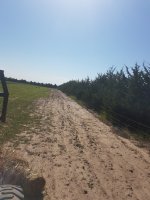High Plainsman
New member
This is kind of opposite of the title topic, but I have a strip of ground that is about 20 feet wide and runs the length of a row of cedar trees that nothing will grow on. Early on after planting the trees, I had good success growing cover/forage crops. When I first noticed it, the bare strip was only about 2 feet wide. I attributed it to the sheep walking the fence line and making a path. But each year it gets wider. I had the soil tested and there was no chemical toxicity found. Last fall I applied several inches of manure and bedding on it in hopes of getting some organic matter back in the soil. The soil looks dead. Rain runs off without any significant amount soaking in. Most research says that cedar trees do not produce a toxic, but many ranchers I think would disagree.
Does anyone have some advice or suggestions of how to mitigate this situation?
Does anyone have some advice or suggestions of how to mitigate this situation?





